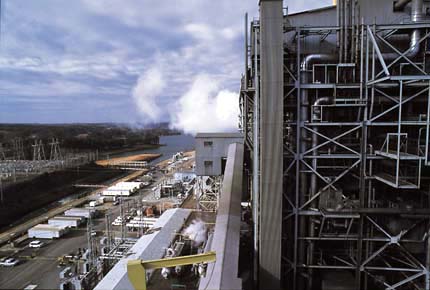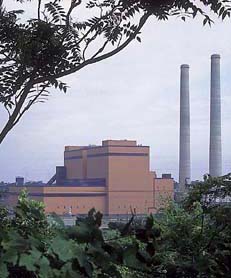Environmental Issues

Under the state's plan to
improve air quality, CP&L's
Roxboro plant (above) will emit 69 percent less nitrogen oxide
in five years than now, as will Duke Power's Belew's
Creek plan (below)
Clearing
the Air
Can the state's aging
coal-fired power plants
slash ozone-causing gases and still keep the lights on?
Related story: State set to impose
tough new emissions test on automobiles
By Steve Tuttle
 In
the
engineering equivalent of trying to teach an old dog new
tricks, state and federal clean-air rules are forcing 14
coal-fired power plants in North Carolina — the
muscular, aging backbone of the state's electric grid
built decades ago when pollution-control technology was
in its infancy — to emit, relatively speaking,
hardly a puff of smoke. In
the
engineering equivalent of trying to teach an old dog new
tricks, state and federal clean-air rules are forcing 14
coal-fired power plants in North Carolina — the
muscular, aging backbone of the state's electric grid
built decades ago when pollution-control technology was
in its infancy — to emit, relatively speaking,
hardly a puff of smoke.
If all goes as planned
— and at this point that's a big if — the 14
plants will emit 69 percent less nitrogen oxide in five
years than they do now and the air we breathe will be
noticeably clearer. Nitrogen oxide, a byproduct of
combustion, reacts with hydrocarbons in the air —
particularly on hot, muggy summer days when there's
little wind — to form ozone. Officials say about
half of all the ozone in the state can be traced to
emissions from the 14 plants.
Ozone is North Carolina's
most widespread air-quality problem, according to Alan
Klimek, director of the Air Quality Division of the state
Department of Environment and Natural Resources. It is
unhealthy to breathe, particularly for children and
people with asthma and other respiratory problems. It
also can damage trees and crops. After declining markedly
in the 1980s, ozone came storming back over North
Carolina during the 1990s, largely because the state's
rapid population growth meant a million more people were
driving cars and using more electricity, Klimek said.
North Carolina, which has
long prided itself on having air so clean that the sky
overhead was a perpetual Carolina blue, recorded a
shocking 70 ozone-alert days in 1998 and 68 in 1999,
fifth-highest among the 50 states. In 1999, more than
half the state's population suffered through at least one
ozone-alert day.
Determined to reverse this
worrisome trend toward decreased air quality, the state
has focused its strategy on curbing emissions from the
coal-fired power plants, seven of which are owned by
Raleigh-based CP&L and seven by Charlotte-based Duke
Power.
Reacting to public demand
for cleaner air and to pressure from the EPA, the state
Environmental Management Commission last October adopted
rules requiring the coal-fired power plants to clean up
their act. The EMC, the state's chief environmental
regulator, says CP&L and Duke Power must reduce the
amount of nitrogen oxide coming from their coal-fired
plants from a collective 89,000 tons a year now to 37,294
tons in 2004 and then to 28,100 tons in 2006.
Such reductions will be
particularly noticeable at two of the plants — at
CP&L's Roxboro facility in Person County north of
Durham, which is the nation's 10-largest emitter of
nitrogen oxide, and at Duke's Belews Creek facility near
Winston-Salem, the nation's third-largest source of the
pollutant. The EMC's new regulations also mandate
reductions in nitrogen oxide emissions from large
industrial boilers, electric co-generation plants and
petroleum pipeline compressor stations.
Although environmental
groups say the EMC's rules don't go far enough, most
observers applauded the regulatory process and the
result. The rules adopted by the EMC largely reflect a
compromise hammered out by Gov. Jim Hunt that straddled
demands by environmentalists and what the utilities
believed sound science supported and their shareholders
could stand. In the end there were no public protests and
no lawsuits.
CP&L and Duke Power
are now moving ahead with plans to install
state-of-the-art pollution-control equipment at the
plants known as Selective Catalytic Reduction systems, or
SCRs. They are highly effective and dearly expensive,
costing $50 million a pop. CP&L is well along on a
major upgrade at its Roxboro plant, where utility
spokesman Mike Hughes says the first of five SCRs to be
installed there will be operational by June.
Both CP&L and Duke
Power already were in the process of making smaller
reductions of emissions from their coal-fired generating
plants. To comply with federal regulations aimed at
reducing acid rain, Duke Power over the past two years
has invested $50 million in equipment that cut emissions
from its plants by 40 percent. CP&L has spent $140
million modernizing five of its plants in a move that cut
its nitrogen oxide emissions by 50 percent.
The utilities are willing
to spend that kind of money to keep the aging plants in
operation because they're paid for, they're very reliable
and relatively cheap to operate. Coal always has been and
still is the cheapest source of fuel for generating
electricity. The 14 coal-burning plants produce 60
percent of all the electricity consumed in the state and
they are a main reason that electric rates are as low as
they are here, compared to other states.
But even as Duke Power and
CP&L begin the five-year process of complying with
the new state rules, officials at the two utilities and
others in the electric industry are raising some
important concerns.
Their biggest problem is
purely technical: How quickly can they solve the
difficult engineering challenge of installing SCRs at
plants — some of which are nearly 40 years old
— that simply weren't designed to operate under such
strict, tricky controls. They say it's like making the
exhaust from a '68 Cadillac as clean as what comes out of
a new Honda Civic without decreasing the old land yacht's
pick-up or performance.
Compounding the
engineering problem is the clock: The plants will largely
have to be shut down for the installation of the new
pollution controls. The utilities are loath to do that
during the summer, when air conditioners are humming, or
in the winter, when most people crank up the thermostat.
So that means the work can only be done in spring and
fall months when the demand for electricity is at its
lowest.
“What we're nervous
about,” says Duke Power official George Everett,
“is that we will have to take these plants off line
to make these retrofits. And Duke and CP&L will be
doing this at the same time. What happens if these
outages get extended beyond the off-peak times of
year?”
Normally that wouldn't be
amajor problem, Everett says, because Duke and CP&L could make up the difference by
buying power from utilities in other states. But that's
not a dependable option now, he notes, because utilities
in 22 states east of the Mississippi will, to varying
degrees, be going through the same process. To comply
with new clean-air regulations imposed by the EPA,
utilities in all those states will be idling their old
coal-fired power plants at various times to install
equipment to reduce nitrogen oxide emissions.
“Usually we'd be able
to help each other out. But this time we're all in the
same boat,” Everett says.
The states involved are
Alabama, Connecticut, the District of Columbia, Delaware,
Georgia, Illinois, Indiana, Kentucky, Massachusetts,
Maryland, Michigan, Missouri, North Carolina, New Jersey,
New York, Ohio, Pennsylvania, Rhode Island, South
Carolina, Virginia, Wisconsin and West Virginia.
Several officials
contacted for this story say it will be critical not only
for Duke Power and CP&L to coordinate when they idle
their plants in North Carolina but also for the utilities
across the 22 states to cooperate in how and when their
coal-fired generation facilities are out of service. No
one wants to repeat Cali-fornia's recent experience of
brownouts and possible utility bankruptcies.
“If you remember, the
whole chain of events in California began last fall when
a few generation plants were taken out of service for
environmental reasons,” Everett says. “That
reduced supply just enough to trigger the crunch and
created a big problem for folks out there.”
Moreover, CP&L and
Duke Power can't just go down to Wal-Mart and buy a bunch
of SCRs. There are only one or two companies capable of
manufacturing the type of SCRs that the utilities need
and only a handful of construction companies with crews
trained in such installations available for hire.
“We will be competing
in a relatively small pool for these new technologies,
for purchasing them and hiring the crews to have them
installed,” Hughes says.
And the inevitable is
occurring when demand increases for a product in short
supply, says Everett. “We already have bid one (SCR
installation) and we are in the process of engineering
and bidding a couple of other units. We anticipate the
first actual construction by 2002. What we've learned so
far is our costs are going up faster than we ever thought
possible.”
It will help a lot if the
state gives Duke Power and CP&L a little flexibility,
officials for both companies say. “What we initially
talked with the state about and continue talking about is
that instead of requiring a specific technology and a
target (of emissions reduction) for each specific plant,
that we be given a target of so many tons to reduce
(collectively for all the plants) and then give our
engineers the flexibility to meet that target,”
Everett says.
“I think the state
understands our concerns,” Everett adds, “but
whether they will do anything about it is not clear
yet.”
And even as Duke Power and
CP&L begin this latest upgrade of their 14 plants,
another regulatory hurdle is appearing on the horizon.
The EPA recently announced it was starting a new
rulemaking proceeding aimed specifically at coal-fired
power plants.
“We certainly support
cleaner air,” Hughes says, “but it does bear
mention that this involves a significant cost and the
option at some point to recover these costs (from
consumers). We're planning to spend between $280 and $370
million between now and 2005. That's beyond the $175
million we've already spent on clear air technology. And
just this week the EPA indicated it will begin to
regulate mercury emissions from coal-fired power plants
and over the next three years they will develop rules as
to what that standard will be. What that will cost nobody
knows.”
And while everyone agrees
that less nitrogen oxide in the air is good for everyone,
Klimek, the state's top air-quality official, even
concedes that scientists sometimes oversimplify matters
by laying the whole blame on industrial sources. For
reasons that aren't readily apparent, the 68 ozone-alert
days in 1999 suddenly dropped to 35 in 2000 — before
the first SCR was working at any of the coal-fired power
plants.
Why the sharp drop? Klimek
shrugs his shoulders. “There are a lot of factors
you can attribute it to,” he says, “but the
simplest answer is we had a real hot summer in 1999. Hot,
still air is a cooker for ozone. Last summer it wasn't
quite so hot.”
Return to magazine index
|

